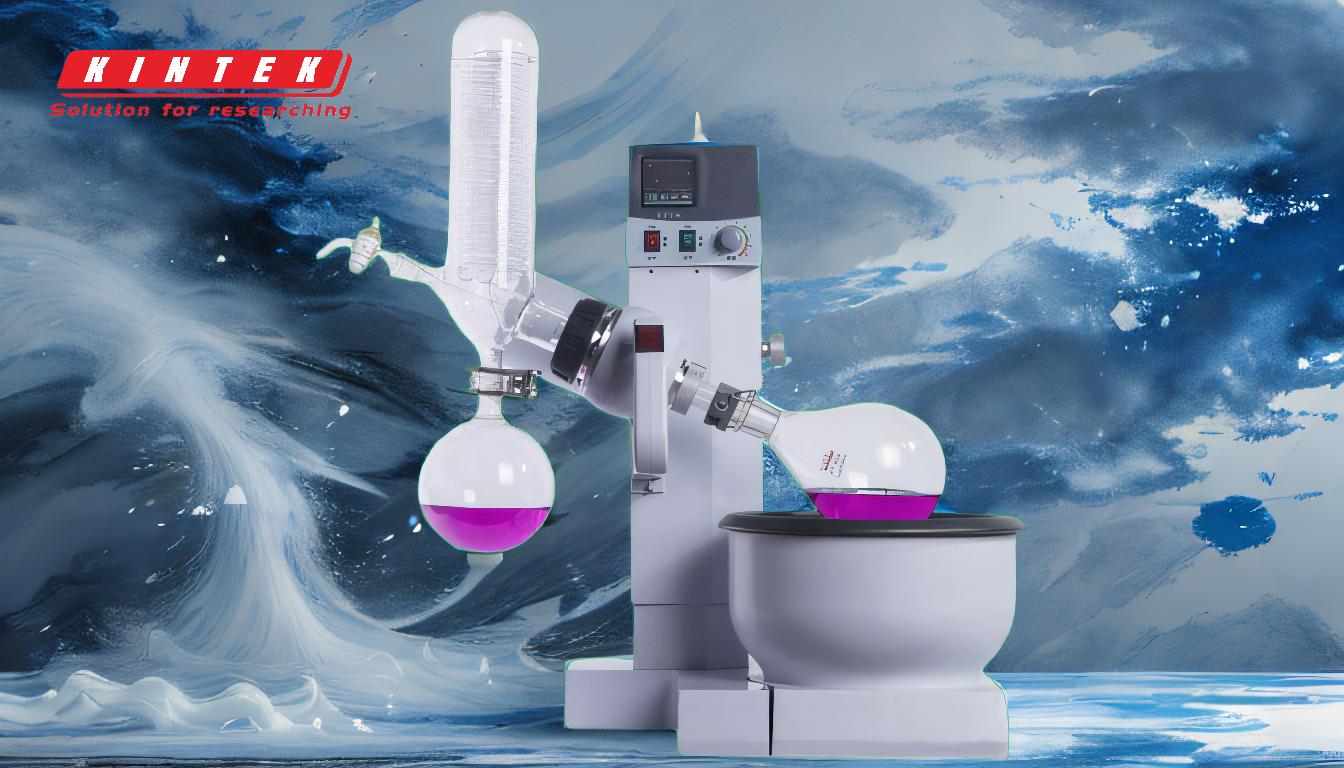A rotovap (rotary evaporator) is more efficient than traditional distillation due to its ability to operate under vacuum conditions, which lowers boiling points and reduces the risk of overheating sensitive materials. The rotating flask increases the surface area of the liquid, enabling faster and more uniform evaporation. Additionally, the rotovap provides precise control over the distillation process, ensuring that delicate components are not damaged by excessive heat. This results in higher recovery rates of solvents and better preservation of the original flavor and chemical profiles of the materials being distilled.
Key Points Explained:

-
Lower Boiling Points Under Vacuum Conditions:
- Traditional distillation relies on heating the mixture to its boiling point at atmospheric pressure, which can be too high for heat-sensitive compounds.
- A rotovap operates under reduced pressure (vacuum), which significantly lowers the boiling points of liquids. This allows distillation to occur at much lower temperatures, preserving the integrity of delicate compounds such as flavors, essences, and volatile organic compounds.
-
Increased Surface Area for Faster Evaporation:
- The rotating flask in a rotovap creates a thin film of liquid on the inner surface of the flask. This greatly increases the surface area exposed to heat and vacuum, accelerating the evaporation process.
- In contrast, traditional distillation relies on a static liquid surface, which limits the rate of evaporation and requires more time to achieve the same separation.
-
Precise Control Over the Distillation Process:
- Rotovaps allow for fine-tuning of parameters such as temperature, pressure, and rotation speed. This precision ensures that the distillation process is optimized for the specific properties of the material being processed.
- Traditional distillation lacks this level of control, making it harder to avoid overheating or degradation of sensitive compounds.
-
Even Mixing and Heating:
- The rotation of the flask ensures that the liquid is constantly mixed, promoting uniform heating and evaporation. This reduces the risk of localized overheating and ensures a more stable distillation process.
- In traditional distillation, uneven heating can lead to hotspots, which may damage sensitive components or cause inconsistent results.
-
Higher Recovery Rates of Solvents:
- Rotovaps are designed to recover nearly 100% of the solvent, making them highly efficient for applications where solvent reuse is important.
- Traditional distillation often results in lower recovery rates due to losses from evaporation, condensation inefficiencies, or incomplete separation.
-
Preservation of Flavor and Chemical Profiles:
- By operating at lower temperatures and with precise control, rotovaps can separate components without altering their chemical structure or flavor profile. This is particularly important in industries like food, beverage, and pharmaceuticals, where maintaining the integrity of the product is critical.
- Traditional distillation, with its higher temperatures and less precise control, is more likely to degrade or alter sensitive compounds.
-
Versatility in Applications:
- Rotovaps can handle a wide range of materials, including liquids, solids, and mixtures. They are capable of removing undesirable elements like tannins, colors, or bitterness while retaining desired flavors and essences.
- Traditional distillation is less versatile and may struggle with complex mixtures or materials that are prone to degradation at higher temperatures.
In summary, the rotovap's efficiency stems from its ability to operate under vacuum, increase surface area, provide precise control, and ensure even mixing and heating. These features make it superior to traditional distillation for applications requiring the preservation of delicate compounds, high solvent recovery, and versatile processing capabilities.
Summary Table:
| Feature | Rotovap | Traditional Distillation |
|---|---|---|
| Boiling Point Control | Operates under vacuum, lowering boiling points for sensitive compounds. | Relies on atmospheric pressure, risking overheating of sensitive compounds. |
| Evaporation Efficiency | Increased surface area from rotating flask for faster, uniform evaporation. | Limited surface area, slower evaporation rates. |
| Process Control | Precise control over temperature, pressure, and rotation speed. | Limited control, higher risk of overheating. |
| Heating Uniformity | Even mixing and heating, reducing localized overheating. | Uneven heating, potential hotspots. |
| Solvent Recovery | Nearly 100% solvent recovery, ideal for reuse. | Lower recovery rates due to evaporation and condensation inefficiencies. |
| Preservation of Compounds | Maintains flavor and chemical profiles at lower temperatures. | Higher temperatures may degrade sensitive compounds. |
| Versatility | Handles liquids, solids, and complex mixtures effectively. | Less versatile, struggles with complex or heat-sensitive materials. |
Upgrade your distillation process with a rotovap—contact us today to learn more!









